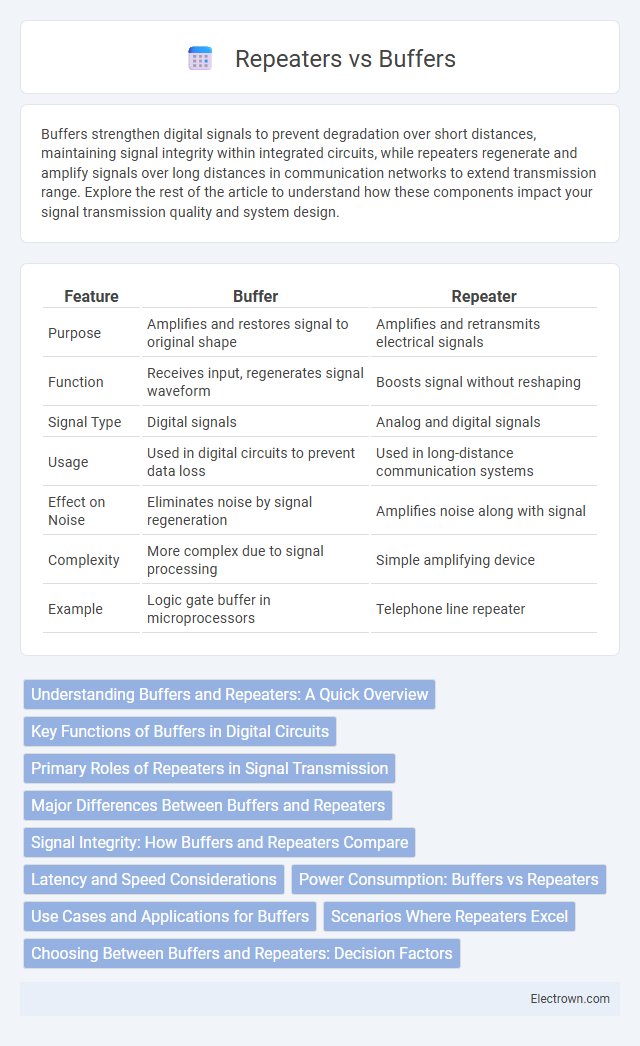Buffers strengthen digital signals to prevent degradation over short distances, maintaining signal integrity within integrated circuits, while repeaters regenerate and amplify signals over long distances in communication networks to extend transmission range. Explore the rest of the article to understand how these components impact your signal transmission quality and system design.
Table of Comparison
| Feature | Buffer | Repeater |
|---|---|---|
| Purpose | Amplifies and restores signal to original shape | Amplifies and retransmits electrical signals |
| Function | Receives input, regenerates signal waveform | Boosts signal without reshaping |
| Signal Type | Digital signals | Analog and digital signals |
| Usage | Used in digital circuits to prevent data loss | Used in long-distance communication systems |
| Effect on Noise | Eliminates noise by signal regeneration | Amplifies noise along with signal |
| Complexity | More complex due to signal processing | Simple amplifying device |
| Example | Logic gate buffer in microprocessors | Telephone line repeater |
Understanding Buffers and Repeaters: A Quick Overview
Buffers and repeaters are essential devices in digital and communication systems used to maintain signal integrity over long distances. Buffers isolate different circuit stages, preventing signal degradation by restoring voltage levels and reducing noise interference, while repeaters amplify and regenerate signals to extend transmission range in networks such as Ethernet or fiber optics. Both play a critical role in ensuring reliable data transfer by overcoming attenuation and distortion challenges.
Key Functions of Buffers in Digital Circuits
Buffers in digital circuits primarily serve to strengthen signal integrity by amplifying weak signals and preventing signal degradation over long transmission lines. They isolate different circuit stages, ensuring that the load from one stage does not affect the previous stage's performance. Unlike repeaters that regenerate and reshape signals, buffers focus on signal stabilization and impedance matching to maintain consistent voltage levels and timing.
Primary Roles of Repeaters in Signal Transmission
Repeaters primarily regenerate and amplify weakened digital or analog signals to extend transmission distance without degradation. They restore signal strength and reshape waveforms to maintain data integrity across long cables or wireless links. This function is crucial in communication networks where maintaining high-quality signal transmission over extended ranges ensures reliable connectivity.
Major Differences Between Buffers and Repeaters
Buffers and repeaters both amplify signals but differ in function and application; buffers primarily restore signal strength and improve signal integrity without altering the timing, while repeaters regenerate and retime digital signals to extend transmission distance. Buffers are ideal for enhancing signal drive capability within circuits, whereas repeaters are crucial in long-distance communication to compensate for signal degradation and timing errors. Your network design benefits from using buffers in integrated circuits and repeaters in extending data transmission across longer cable or fiber optic spans.
Signal Integrity: How Buffers and Repeaters Compare
Buffers and repeaters both enhance signal integrity by amplifying weakened signals, but buffers primarily restore signal strength without significant reshaping, ensuring minimal distortion. Repeaters regenerate the entire signal waveform, effectively correcting timing and degradation issues over longer distances. Your choice depends on whether maintaining original signal quality or extending transmission range is the priority.
Latency and Speed Considerations
Buffers help reduce latency by temporarily storing data and ensuring smooth signal transmission, which maintains high speed over longer distances. Repeaters regenerate and amplify signals to extend range but can introduce slight delays due to signal processing time. Your choice between buffers and repeaters impacts network performance, with buffers typically offering lower latency and improved speed consistency.
Power Consumption: Buffers vs Repeaters
Buffers generally consume less power than repeaters because they amplify signals without the need to fully regenerate the waveform. Repeaters, which receive and retransmit signals to restore signal integrity over long distances, typically use more power due to the increased processing and signal regeneration involved. In high-speed digital circuits, minimizing power consumption makes buffers a preferred choice for signal boosting in short to medium interconnects.
Use Cases and Applications for Buffers
Buffers are primarily used in digital circuits to strengthen signal integrity by restoring signal voltage levels without altering the timing, making them essential in driving high-capacity loads or long bus lines in microprocessors and memory modules. They find applications in data communication systems to isolate circuit stages and prevent signal degradation caused by capacitive loading effects. Buffers are crucial in timing-critical applications where preserving the original signal phase is necessary, such as clock distribution networks and synchronous logic circuits.
Scenarios Where Repeaters Excel
Repeaters excel in scenarios where signal regeneration over long distances is essential, such as extending Ethernet connections beyond standard length limits or boosting Wi-Fi signals in large buildings. They are ideal for environments with high signal attenuation, ensuring your network maintains integrity without degradation. Using repeaters in these cases helps preserve data quality by amplifying digital signals directly, making them a critical choice for robust network expansion.
Choosing Between Buffers and Repeaters: Decision Factors
Choosing between buffers and repeaters depends on signal integrity, distance, and network complexity. Buffers amplify digital signals while maintaining timing synchronization, making them ideal for applications requiring minimal delay. Repeaters regenerate and reshape signals over long distances, ensuring clear data transmission in extensive networks where signal degradation is a concern.
Buffers vs repeaters Infographic

 electrown.com
electrown.com